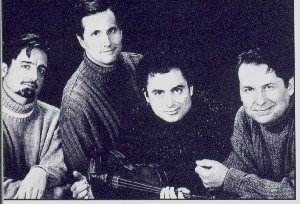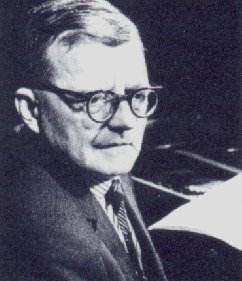"Through listening to the silences and the desolation, the violence and the tragedy...Each one of his quartets is like a letter from a forbidden place of which we know nothing". - David Finckel, cellist
For the last ten days packed audiences at the Wigmore Hall and the Barbican have been allowed access to the forbidden world of Shostakovich's quartets. Whilst it would be true to say that at the earlier concerts we were being sent postcards, rather than intimate letters, by the final concert we were privy to what can only be described as the most soul-searching and private of diaries, glimpsing pages that were written under the most tragic of circumstances. That the Emersons were able to make this seem an experience almost uniquely singular in its effect was an astonishing achievement. The performance of the Fifteenth Quartet - the summation of both Shostakovich's cycle and the Emerson's artistic triumph - really seemed to unlock the isolation of one's own mind making each and everyone of us totally, and frankly, aware of the tormented soul Shostakovich had become in his last years.But the Fifteenth Quartet is an extraordinary work. With six adagios, over a time-span of almost 40 minutes, it is the most haunting of all the quartets. We heard it with the hall plunged into near total darkness, the Emersons almost disembodied on stage and surrounded by only the shallowest mirage of light. It is certain they could not see us - this really was the most intimate and private of readings. The timelessness of this performance was incandescently drawn: a landscape of elegiac tension was punctuated by barely suppressed terror, the silence shattered by distilled dissonance. The hall fell into total silence and at the end bows hovered above strings for an eternity. The last notes had trembled to their close, but despair had been overcome.
The playing had been fabulous. Philip Setzer had achieved miracles in the Intermezzo, the sound spun from the purest silk. Lawrence Dutton's viola was an oasis of velvety darkness. A truly wonderful performance.Earlier in the afternoon we had heard the Thirteenth and Fourteenth quartets. The hallucinatory properties of these works were painted like an unfolding drama. The atonalism of the Thirteenth was thrillingly exposed, the grotesque string balances drawn like a Cubist nude - all fragmentation and distortion. The Fourteenth, with its many solos, was a masterpiece of isolation. David Finckel's cello was darkly sonorous, the tone impassioned. In the Thirteenth, Lawrence Dutton had been an unsurpassable hero. His last notes had astonishing purity, the viola's climb to it's highest summit heavenly and timeless.
I am convinced that something special happened at this concert which had been largely missing from the earlier ones. The late quartets seemed to inspire the Emersons to playing that was genuinely intense and dramatic. There was an impassioned and expressive nobility to the playing, not least in the adagios where the transfiguration was not only beautifully phrased but also understood. In the earlier concerts one could sense a palpable superficiality to the playing, as if meaning had somehow been dissipated in favour of a glowing virtuosity. At this final concert, expression and dynamic articulation went hand-in-hand.
This had certainly not been the case at their second Wigmore Hall concert. The Third and Fourth quartets received performances that were stunningly played, but which didn't quite get under the skin of Shostakovich's abstract methodology. The Third should have a dynamic balance - with its mix of waltzes and marches and fugues - but the Emersons largely underplayed this. Instead, they presented us with a distinctively drawn set of cameos which ultimately seemed unrelated to the unravelling argument of the work. The Fourth was more successful. Here they balanced menace with droning dance rhythms and an echt Jewishness. All the allegrettos were swiftly played, although again I was concerned about a lack of empathy with the psychological undertones Shostakovich now begins investing his quartets.
If there is a developing pattern to the Emerson's cycle it must be that the later music brought a greater responsibility on their part to present these works with more mystery. If the vast Ninth lacked the monumentalism it's structure so clearly implies, the actual metamorphosis from mid to late works did make for more challenging listening. This performance might have been more passive than their new DG recording of the work, but it evoked many memorable things. Philip Setzer's vibrato throughout this work was astonishingly eerie and the viola had a darkness and broodiness that was genuinely sombre. The final allegro was thrilling. It was the Tenth Quartet, however, which really set the imagination on fire. The parallels with the Tenth Symphony (at least in terms of structure) were magnificently drawn. The menacing allegro furioso (so reminiscent of the symphony's scherzo) was bravura stuff indeed. If it was really left for the cello and viola to impregnate this movement with elemental terror it didn't matter. The articulation from all four players was phenomenal. Perhaps in the adagio the violins were too sweet-toned, and neither Setzer nor Drucker quite balanced their tone successfully enough to compete with the melancholic grieving of the cello or viola. The real desolation in this performance (as in so many others in this cycle) was really only evoked by the yearning viola of Lawrence Dutton.
For the Barbican concerts each of the quartets was illustrated by an image projected on a screen behind the players. With one exception, these images did not have any contextual reason for appearing during the particular quartet it accompanied. Vladimir Yakovlev's Head with Hand (1974) seemed the only image which was relevant. A grotesque, Cubist painting with a vast hand hiding half of the face, fingers curving like a scythe, it seemed appropriate to accompany the Tenth Quartet. With an inverted hammer forming the upper lip, it appeared strangely relevant to the aesthetic strategy. Whether in the end the idea of using images was a good one is questionable. They appeared at first to move the focus from the music to the art, but assuredly by the final concert the level of playing has reached such a peak one simply forgot they were there so immersed were we in the music making.
I had initially thought the Barbican too big for the intimacy of Shostokovich's quartets. The Wigmore Hall recitals had certainly opened out the sound more naturally, and there were problems with the Ninth and Tenth quartets in the Barbican's bigger space. For the last three quartets, however, the Barbican was almost ideal. By some miracle, the violin played by Philip Setzer (made in 1999 by Samuel Zygmuntowicz) achieved a breadth of tone that had alluded it in all the earlier concerts. I was more than conscious of the brightness of this instrument, compared with Eugene Drucker's 1686 Strad, and even more so when the leader's role is a shared one. The slow movements Setzer had lead in the earlier concerts did not quite have the depth of tone one can hear on the DG discs, but this was more than corrected for the final triumvirate.
The Emerson's technique is peerless. Although the earlier concerts perhaps disappointed in not being as spellbinding as the last ones, one could always amaze at the fleetness of the playing. Lawrence Dutton is exceptional, a musician through to his fingertips, but all members have at some stage filled me with admiration for their undoubted musicianship. I assume the standing ovation they received on Sunday after their performance of the Fifteenth Quartet was in tribute to the whole cycle. Personally, it was worthy of the final quartet alone. A thrilling series.
Marc Bridle
See review of the complete recording


 Return to:
Return to: